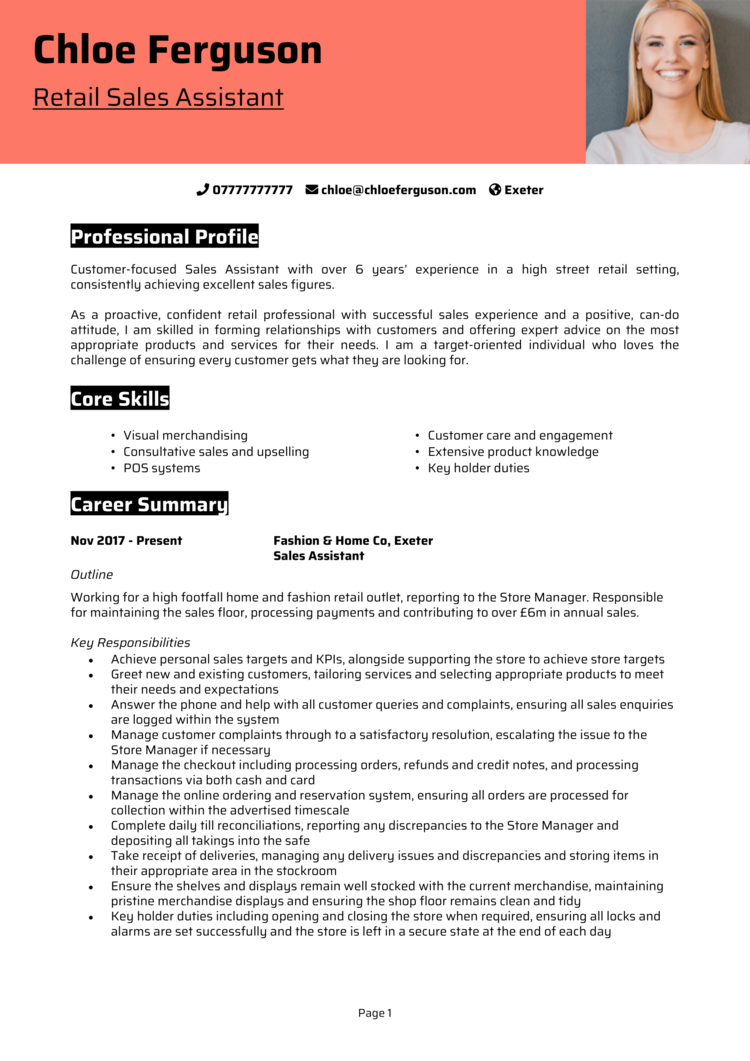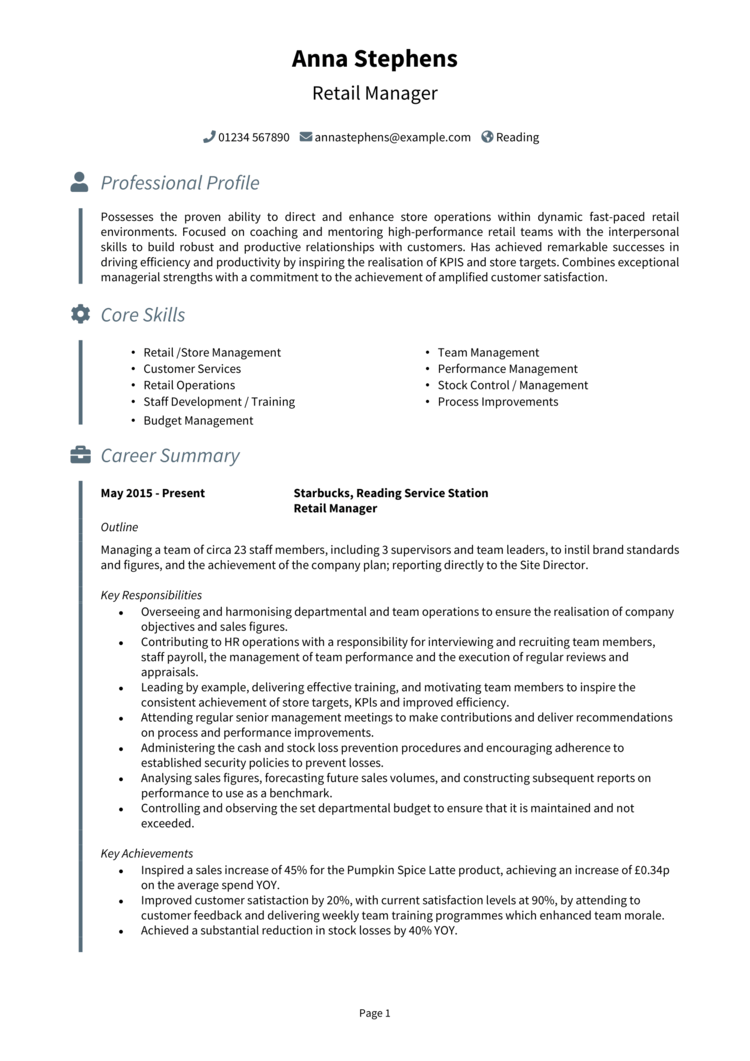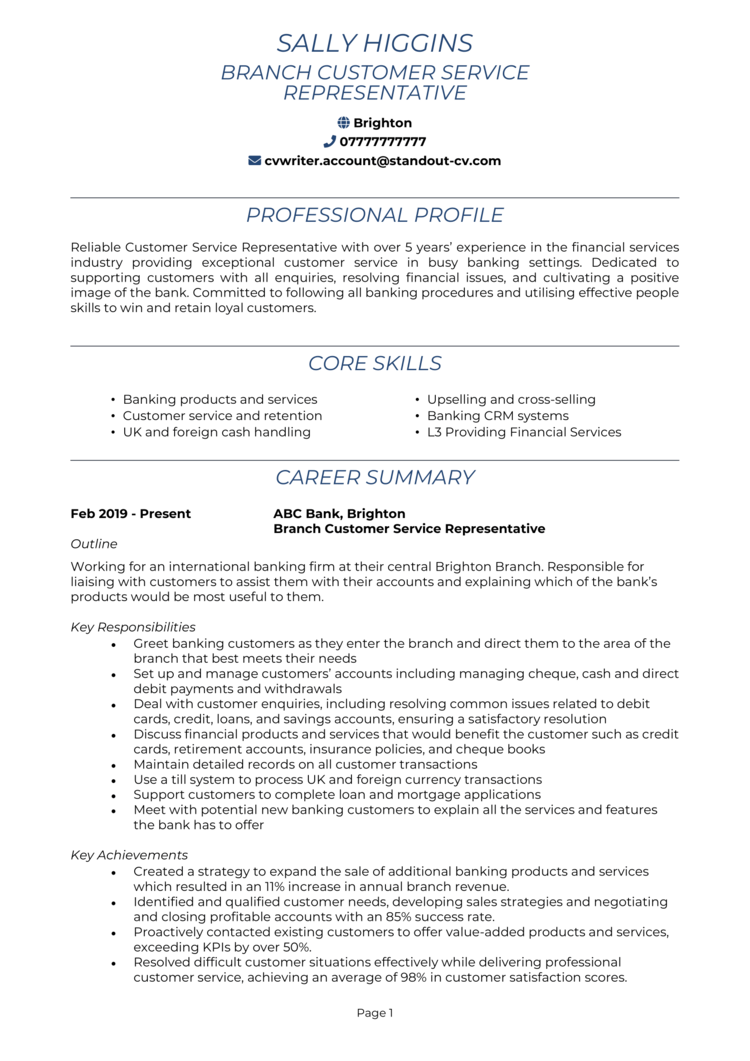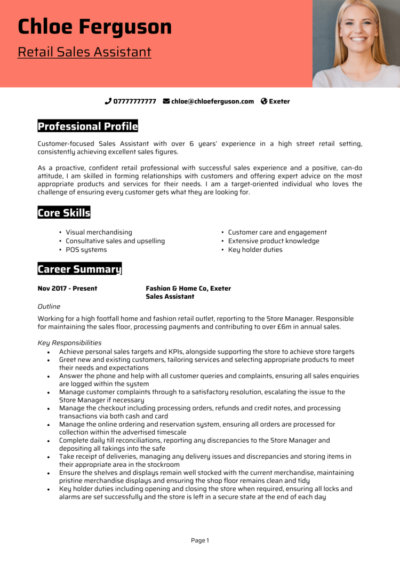Your retail job is all about keeping things running smoothly and making sure every shopper leaves happy (and hopefully with more than they planned to buy).
Whether you’re working the shop floor, managing inventory, or leading a team, your CV needs to show that you’ve got the skills to thrive in a fast-paced retail environment.
This guide, along with 6 Retail CV examples, will take you through the key steps in creating a retail CV that stands out to employers, ensuring your application is as polished as the store displays you put together.
Retail Sales Assistant CV example

Retail Manager CV example

Supervisor CV example

Customer Service CV

Jewellery Sales Assistant CV

Sales Advisor CV example

How to write your Retail CV
Learn how to create your own interview-winning Retail CV with this simple step-by-step guide.
A well-structured retail CV should be as organised as a neatly stocked shelf. If recruiters have to dig through clutter to find your skills, they might move on faster than a shopper spotting a ‘closing down sale’ sign.
This guide will show you how to write your CV, structure your work experience, and highlight the key skills that make you a strong retail candidate. You’ll have a CV that gets attention – just like the best in-store promotions.
Structuring your Retail CV


Retail employers don’t have time to search through a messy CV – if they wanted to dig through piles of disorganised stock, they’d just check the clearance section. A clear and logical layout makes sure they can quickly find what they need.
Here’s how to set up your CV structure:
- Name and contact details – Keep your personal details at the top where they can’t be missed, along with an optional photo.
- Profile – A strong opening that highlights your experience, skills, and customer service abilities.
- Core skills – A quick list of your most relevant skills, such as sales, stock management, or cash handling.
- Work experience – Detail your previous retail roles in reverse chronological order, showing your impact in each position.
- Education – List your qualifications, like degrees and certificates, starting with the most recent.
- Additional info – If relevant, mention extra things like any related hobbies, languages spoken, or awards.
CV format for a Retail role


Presentation matters. If your CV formatting looks disorganised, a hiring manager might assume your stockroom would look the same.
Even the most qualified candidates would miss out if they made simple formatting mistakes, so put your attention to detail to good use here.
Stick to these formatting tips for the best results:
- Bullet points – Help the recruiter skim your CV quickly and pick up the important bits with ease.
- Divide sections – Logically organise the information and make it easy to navigate.
- Use a clear and readable font – Keep your font professional, ensuring it’s easy to scan quickly.
- No more than 2 pages – 2 pages is the perfect length to cover the essentials without getting boring.
How to create a Retail CV profile


Your CV profile is your shop window – it needs to grab attention and make employers want to know more. This short section at the top of your CV should summarise your skills, experience, and strengths in retail, all to convince recruiters why hiring you would benefit them.
Less experienced candidates should go for a personal statement, which is longer and focuses more on your aspiration.
Retail CV profile examples
Profile 1
Customer-focused Retail Associate with three years of experience in high-street fashion, specialising in customer service, sales, and merchandising. Skilled in operating POS systems, managing stock levels, and providing personalised shopping experiences. Adept at handling busy environments while maintaining excellent customer engagement and meeting sales targets.
Profile 2
Results-driven Retail Supervisor with five years of experience leading teams in large retail stores. Skilled in team training, stock management, and visual merchandising. Experienced in using sales analytics tools to optimise store performance and improve customer experience. Passionate about driving revenue growth and maintaining high customer satisfaction.
Profile 3
Experienced Retail Manager with over seven years of expertise in store operations, inventory control, and staff development. Skilled in implementing sales strategies, reducing shrinkage, and improving operational efficiency. Adept at managing high-volume retail environments and delivering excellent service through strong leadership and customer engagement.
What to include in your Retail CV profile
To make an impact, include the following:
- Where you’ve worked – Have you worked in high street retail, supermarkets, luxury brands, or independent stores? Say which type, and how many years of experience.
- Key customer service skills – Do you have experience in upselling, handling complaints, or managing queues?
- Sales experience – If you’ve consistently hit or exceeded sales targets, mention it here.
- Stock and merchandising knowledge – Employers value staff who can keep shelves stocked and displays looking their best.
- Leadership abilities – If you’ve trained new staff, supervised a team, or managed store operations, highlight it.
Core skills section


A core skills section helps employers quickly see what you bring to the role. Make sure to list skills relevant to retail: think of it like a store’s ‘bestsellers’ shelf – highlight the skills that will catch a recruiter’s eye first.
Tailor your CV skills to match the job description, focusing on the skills that matter most for the role you’re applying for.
Want a retail CV that catches employers’ attention?
Our CV builder has you covered with tailored pre-written content, stylish templates, and expert advice to help you craft a polished, professional CV in minutes.
Top skills for your Retail CV
- Customer Service Excellence – Providing a positive shopping experience by assisting customers and addressing their needs.
- Point of Sale (POS) Operation – Processing transactions, handling cash, and managing digital payment systems efficiently.
- Merchandising and Display – Arranging products strategically to enhance visual appeal and maximise sales.
- Inventory Management – Tracking stock levels, restocking shelves, and conducting inventory checks to prevent shortages.
- Product Knowledge – Understanding features, benefits, and specifications of products to assist customers effectively.
- Loss Prevention Techniques – Identifying and preventing theft, fraud, and inventory shrinkage through vigilant monitoring.
- Sales and Upselling – Recommending products and promotions to boost sales and enhance the customer experience.
- Store Operations – Ensuring the store runs smoothly by managing daily tasks like opening, closing, and maintaining cleanliness.
- Complaint Resolution – Handling customer concerns professionally to maintain satisfaction and brand reputation.
- E-commerce and Omnichannel Support – Assisting with online orders, click-and-collect services, and digital customer interactions.
Work experience


Your work experience section should show more than just where you worked – it should prove how you made a difference. Employers want to see how you’ve helped improve sales, kept stores running smoothly, or delivered great customer experiences.
List your jobs in reverse chronological order, focusing on key responsibilities and achievements in each role. If you don’t have much retail experience, highlight transferable skills from other customer-facing jobs or volunteer work.
How to format previous jobs in your CV correctly

- Outline – Introduce the store or company you worked for and your role within the team.
- Responsibilities – Describe your key tasks, such as assisting customers, processing sales, or restocking displays. Use action words like “advised”, “assisted”, and “managed”.
- Achievements – Highlight measurable successes, such as increasing sales, improving customer satisfaction scores, or training new team members.
Example jobs for Retail
Sales Assistant | StylePoint
Outline
Provided excellent customer service in a fast-paced fashion retail store, assisting shoppers with product selection and checkout.
Responsibilities
- Welcomed and assisted customers, ensuring a positive shopping experience.
- Operated the cash register and processed transactions accurately.
- Maintained a clean and organised store layout to enhance product visibility.
- Restocked shelves and assisted with inventory management.
- Promoted special offers and loyalty programmes to boost customer retention.
Achievements
- Increased store sales by 15 percent through effective upselling techniques.
- Received recognition for excellent customer service and product knowledge.
- Helped reduce checkout wait times by 20 percent by improving efficiency at the till.
Retail Supervisor | Gadget4u
Outline
Led a team of sales assistants in a busy electronics store, ensuring smooth daily operations and strong customer engagement.
Responsibilities
- Managed staff schedules, ensuring adequate coverage during peak hours.
- Trained and mentored new team members on product knowledge and sales techniques.
- Monitored stock levels and coordinated with suppliers to prevent shortages.
- Handled customer inquiries and resolved complaints professionally.
- Assisted in visual merchandising and promotional displays to enhance store appeal.
Achievements
- Managed staff schedules, ensuring adequate coverage during peak hours.
- Trained and mentored new team members on product knowledge and sales techniques.
- Monitored stock levels and coordinated with suppliers to prevent shortages.
- Handled customer inquiries and resolved complaints professionally.
- Assisted in visual merchandising and promotional displays to enhance store appeal.
Retail Store Manager | Everyday Essentials
Outline
Oversaw the daily operations of a homeware retail store, managing staff, stock, and sales strategies to maximise revenue.
Responsibilities
- Developed and executed sales strategies to meet and exceed revenue targets.
- Supervised a team of 15+ employees, providing training and performance feedback.
- Managed inventory control, reducing stock discrepancies and minimising waste.
- Analysed sales reports and adjusted merchandising strategies based on trends.
- Ensured compliance with health and safety regulations and company policies.
Achievements
- Increased store profitability by 30 percent through targeted sales initiatives.
- Reduced staff turnover by 20 percent by improving training and employee engagement.
- Achieved the highest customer satisfaction scores in the region for two consecutive years.
Education section


While experience matters most in retail, your education section should still be well-structured. If you’re applying for an entry-level role, your qualifications might be more important, so highlight any coursework relevant to business, sales, or customer service.
If you have additional retail-related certifications, such as health and safety training or a customer service diploma, include those here.
List qualifications in reverse chronological order, starting with the most recent.
Qualifications recruiters look for in a Retail role
- Retail Skills Certificate (City & Guilds) – A valuable certification covering essential retail skills.
- Diploma in Customer Service (BTEC or NVQ) – Demonstrates expertise in handling customers and improving satisfaction.
- Health and Safety in Retail (Level 2 Award) – Shows an understanding of workplace safety in a retail environment.
- Sales and Marketing Diploma – Useful for retail roles that involve promotions and upselling.
- First Aid at Work Certification – Some retail employers value staff who are trained in first aid for customer and employee safety.





